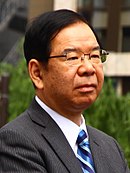You can help expand this article with text translated from the corresponding article in Japanese. (July 2022) Click [show] for important translation instructions.
|
| |||||||||||||||||||||||||||||||||||||||||||||||||||||||||||||||||||||||||||||||||||||||||||||||||||||||||||||||||||||||||||||||||||||||||||||
124 of the 248 seats in the House of Councillors 125 seats needed for a majority | |||||||||||||||||||||||||||||||||||||||||||||||||||||||||||||||||||||||||||||||||||||||||||||||||||||||||||||||||||||||||||||||||||||||||||||
|---|---|---|---|---|---|---|---|---|---|---|---|---|---|---|---|---|---|---|---|---|---|---|---|---|---|---|---|---|---|---|---|---|---|---|---|---|---|---|---|---|---|---|---|---|---|---|---|---|---|---|---|---|---|---|---|---|---|---|---|---|---|---|---|---|---|---|---|---|---|---|---|---|---|---|---|---|---|---|---|---|---|---|---|---|---|---|---|---|---|---|---|---|---|---|---|---|---|---|---|---|---|---|---|---|---|---|---|---|---|---|---|---|---|---|---|---|---|---|---|---|---|---|---|---|---|---|---|---|---|---|---|---|---|---|---|---|---|---|---|---|---|
| Opinion polls | |||||||||||||||||||||||||||||||||||||||||||||||||||||||||||||||||||||||||||||||||||||||||||||||||||||||||||||||||||||||||||||||||||||||||||||
| Registered | 105,019,203 ( | ||||||||||||||||||||||||||||||||||||||||||||||||||||||||||||||||||||||||||||||||||||||||||||||||||||||||||||||||||||||||||||||||||||||||||||
| Turnout | 52.05% ( 52.04% ( | ||||||||||||||||||||||||||||||||||||||||||||||||||||||||||||||||||||||||||||||||||||||||||||||||||||||||||||||||||||||||||||||||||||||||||||
| |||||||||||||||||||||||||||||||||||||||||||||||||||||||||||||||||||||||||||||||||||||||||||||||||||||||||||||||||||||||||||||||||||||||||||||
 Results by constituency | |||||||||||||||||||||||||||||||||||||||||||||||||||||||||||||||||||||||||||||||||||||||||||||||||||||||||||||||||||||||||||||||||||||||||||||
| |||||||||||||||||||||||||||||||||||||||||||||||||||||||||||||||||||||||||||||||||||||||||||||||||||||||||||||||||||||||||||||||||||||||||||||
House of Councillors elections were held in Japan on 10 July 2022 to elect 125 of the 248 members of the upper house of the National Diet, for a term of six years.[1] The elected candidate with the fewest votes in the Kanagawa prefectural district will serve for three years, as the district combined its regular and byelections.[2]
The elections occurred within the first year of premiership of Fumio Kishida, President of the Liberal Democratic Party and it saw Kenta Izumi debut as the Leader of the opposition Constitutional Democratic Party. The election was overshadowed by the assassination of former Prime Minister Shinzo Abe (served 2006–2007 and 2012–2020), which took place two days before ballots were cast.[3] Abe was shot while delivering a campaign speech for Kei Satō, a member of the House of Councillors running for reelection. The assassin, who had previously served in the Japan Maritime Self-Defence Force, was arrested at the scene and reportedly confessed to targeting Abe due to a grudge he held against the Unification Church. Prime Minister Kishida denounced the assassination as an attack on Japan's democracy and vowed to defend a "free and fair election at all cost".[4] In a post-election survey, 62.5 percent of the voters said their votes were not swayed by the assassination, while 15.1 percent said they were.[5]
The governing Liberal Democratic Party modestly increased its seats in the chamber.[6] Turnout slightly increased compared to the previous election[7] while a new record was set for women elected to the chamber at 28%.[8] Parties supportive of constitutional revision gained a combined total of 93 seats, thus gaining the two-thirds majority needed to trigger the parliamentary procedure which was lost in the 2019 election.[9]
The disparity in the value of a vote between prefectural districts in the election ranged up to 3.03 times, leading to nationwide legal challenges.[10]
- ^ "参院選「22日公示、7月10日投開票」で閣議決定". 産経ニュース (in Japanese). 2022-06-15. Retrieved 2022-06-18.
- ^ "参院選神奈川 県内初の「合併選挙」 改選数4+1、5位当選者は3年後に改選:東京新聞 TOKYO Web". 東京新聞 TOKYO Web (in Japanese). Retrieved 2022-07-12.
- ^ "Japan ex-leader Shinzo Abe apparently shot, in heart failure". Associated Press. 8 July 2022. Archived from the original on 8 July 2022. Retrieved 8 July 2022.
- ^ Sugiyama, Satoshi; Kim, Chang-Ran (2022-07-08). "Shinzo Abe's assassin used a handmade firearm". Reuters. Retrieved 2022-07-08.
- ^ "Japan Cabinet's approval rating rises to highest 63.2% after vote". Kyodo News+. Retrieved 2022-07-12.
- ^ Saric, Ivana (2022-07-10). "Shinzo Abe's political party wins supermajority in parliamentary elections". Axios. Retrieved 2022-07-10.
- ^ "【速報】参院選投票率52.05% 前回上回るも 改選対象の6年前には及ばず". FNNプライムオンライン. 11 July 2022. Archived from the original on 2022-07-16. Retrieved 2022-07-11.
- ^ "参院選 女性当選者が35人で過去最多に 当選者に占める女性比率も過去最高:東京新聞 TOKYO Web". 東京新聞 TOKYO Web (in Japanese). Retrieved 2022-07-11.
- ^ "(Update 4) Japan LDP Achieves Big Victory in Upper House Poll". Jiji Press. 11 July 2022. Retrieved 11 July 2022.
- ^ "Lawsuits filed to contest election results over large vote disparity | The Asahi Shimbun: Breaking News, Japan News and Analysis". The Asahi Shimbun. Retrieved 2022-07-12.








